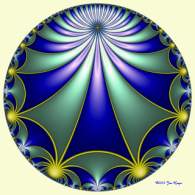 Penrose
Tilings
Penrose
Tilings
http://www.josleys.com/creatures34.htm
Penrose tilings are also known as aperiodic tilings. Aperiodic tilings have the attribute that they do not repeat patterns. The first aperiodic tilings had 7 or more specially constructed tiles. However, Roger Penrose had a penchant for "fun math" and took up aperiodic tiling. For seven years he attempted to reduce the required number of tiles, from 7, to 4, to 2. The two-tile pattern is what we know today as Penrose tilings. Apparently, however, even this obscure geometric construction bears usefulness to science. Penrose tilings apparently mimic the behaviors of quasicrystals, make for a comfortable wipe on toilet paper, and are used in the design of a better no-stick coating for cookware.
Go to The Art and Science of Tilings for more.
Go to The Birth of Zen for a cool Penrose-based picture
The really interesting thing to Penrose about the tilings (besides the fact they bring in income as a patented pattern) is that the solution to the tiling pattern is noncomputational. There was no way through logic to decide whether the Penrose Tilings existed before he found it through trial, error, and instinct.
He uses the tilings in puzzles and games.

http://www.josleys.com/creatures34.htm